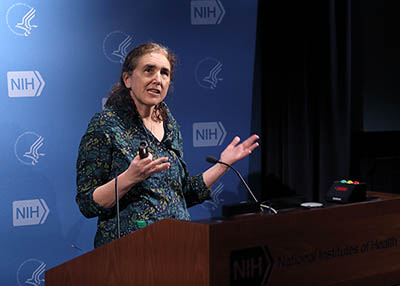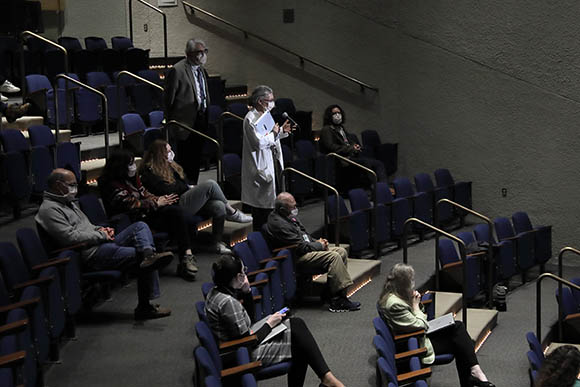First In-Person WALS in Two Years
Anna Huttenlocher Presents Research on Inflammation Resolution and Wound Repair

CREDIT: CHIA-CHI “CHARLIE” CHAN, OD
Anna Huttenlocher, from the University of Wisconsin at Madison, was the first in-person WALS presenter since the onset of the COVID-19 pandemic more than two years ago required NIH to hold its lectures and meetings online only.
The Wednesday Afternoon Lecture Series (WALS) has been videocast-only since the start of the COVID-19 pandemic more than two years ago. But on April 6, 2022, NIH welcomed Anna Huttenlocher, a professor of pediatrics and medical microbiology and immunology at the University of Wisconsin at Madison (Madison, Wisconsin), as the first in-person WALS presenter since the last in-person lecture was held on March 4, 2020. A return to the lecture series’ traditional format allowed for in-person discussion, face-to-face interactions with staff, and questions after the event. More than 30 people attended the lecture in Lipsett Amphitheater (the number of people allowed to attend an event is limited for now). About 200 others watched live via NIH VideoCasting.
“[Huttenlocher is] really passionate about fueling, educating, mentoring, and launching the next generation of scientists and physician–scientists,” said Deputy Director and Acting Scientific Director of the National Institute of Neurological Disorders and Stroke Nina Schor during her introductory remarks.
Huttenlocher’s research focuses on understanding the basic molecular mechanisms that regulate cell movements in the context of wound healing, inflammation, and cancer. Her WALS talk was on neutrophils, which she described for the audience as the “primary cells of the innate immune response [and] the first responders to tissue damage.”

CREDIT: FRANCISCO BARROS BECKER, UNIVERSITY OF WISCONSIN-MADISON
A spinning disc confocal microscope was used to produce live images of an uninjured zebrafish tail (left) and one that has a burn injury (right). Anna Huttenlocher’s lab found that, after a burn injury, more neutrophils (purple) than macrophages (green) tend to migrate to the wound site (far right of the tail).
Her lab uses zebrafish (Danio rerio) as a model system to study the migration and motility of neutrophils, and to understand the balance between their ability to assist with infection and repair as well as their contribution to inflammation. Historically, it was thought that when neutrophils died, they were removed from the site by macrophages, promoting the resolution of inflammation. Huttenlocher’s lab found that instead, neutrophils arrive and depart from wound locations and sites of inflammation in a process known as reverse migration.
To determine what regulates reverse migration, her lab is identifying new mechanisms that regulate inflammation resolution. The researchers have studied various models of injury such as cutting the tail or ear of zebrafish or using heat to burn the tail to pinpoint inflammation-resolving pathways. After a burn injury (which destroys collagen organization) the lab found that more neutrophils than macrophages tend to migrate to the burn wound, an indication that macrophages need collagen to do their work, whereas neutrophils do not.
One of the proteins involved in this pathway is the myeloid derived growth factor (MYDGF). During her talk, Huttenlocher described her lab’s discovery that depletion of MYDGF leads to increased neutrophils at the wound prolonging inflammation. Given the negative impact of diminished MYDGF activity on regulating neutrophil behavior, the lab proposed the protein as a potential therapeutic target to treat inflammatory conditions.

CREDIT: CHIA-CHI “CHARLIE” CHAN, OD
A small, socially distanced and masked audience gathered in NIH’s Lipsett Amphitheater (in Building 10) for the first in-person WALS talk since the start of the COVID-19 pandemic more than two years ago. The featured speaker was Anna Huttenlocher (University of Wisconsin at Madison) whose research focuses on understanding the basic molecular mechanisms that regulate cell movements in the context of wound healing, inflammation, and cancer.
Going forward, the Huttenlocher research group is working with Huy Dinh, assistant professor in the Department of Oncology at the University of Wisconsin’s McArdle Laboratory for Cancer Research. Together, they are trying to understand the diversity in neutrophils and macrophages within interstitial tissues by using live imaging and examining gene expression in individual cells.
For many WALS lecturers, an invitation to speak on campus is about more than just giving a talk—it includes meeting with NIH scientists and trainees. “It was a thrill to meet and talk science in person again,” said Huttenlocher in an email interview with this reporter. It was her first in-person lecture in over two years, too. “We may be a bit rusty! But it’s fun.” During her visit, she had a full day’s schedule of meetings with several NIH scientists across campus who are both old friends and colleagues. She also “enjoyed seeing the remaining cherry blossoms and the start of spring.”
Seems like a lecture on wound healing was the salve we were waiting for.
For more on the NIH Director’s Wednesday Afternoon Lecture Series and to see which lectures will be in person, go to https://oir.nih.gov/wals. To watch a videocast of the lecture, “Imaging Inflammation Resolution and Wound Repair,” held on April 6, 2022, go to https://videocast.nih.gov/watch=44239.

Tamar Jacobsohn is a postbaccalaureate fellow in NICHD’s Contraceptive Development Program, which focuses on the development of new contraception measures for men and women. She is applying to medical school and is interested in the intersection of the women’s health and mental health fields. In her spare time, she likes to hike, read novels, and enjoy a good cup of coffee.
This page was last updated on Tuesday, May 17, 2022
